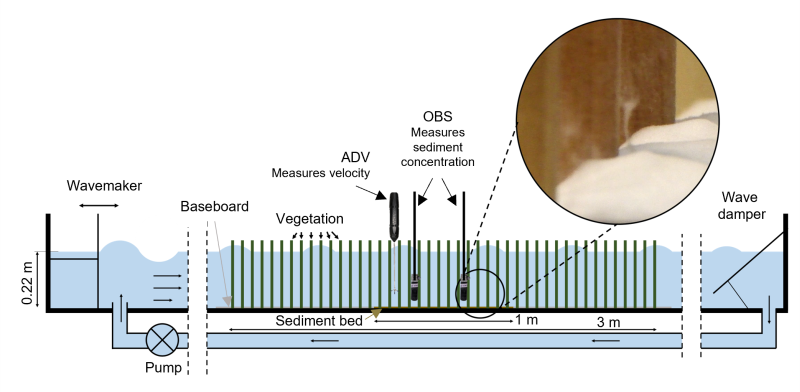T.J. van Veelen1,2*, H.M. Nepf2, S.J.M.H. Hulscher1, B.W. Borsje1
1 University of Twente, The Netherlands; 2 Massachusetts Institute of Technology, United States
* Corresponding author: t.j.vanveelen@utwente.nl
Introduction
Salt marshes and other vegetated foreshores are valuable ecosystems for coastal protection, but they may grow and retreat over time. Salt marshes are intertidal wetlands, whose vegetation attenuates waves, currents and stabilizes foreshores, thereby reducing the load on dikes (Vuik et al., 2016). They also sequester carbon and are an important habitat for marine flora and fauna. Fine sediments are the core of a salt marsh. These are brought in by tides and waves and are deposited on and around the marsh. Understanding the sediment transport dynamics is essential in order to predict the morphological evolution of the marshes and the future protection that salt marshes will provide.
Vegetation modifies sediment transport dynamics compared to a bare bed. The vegetation modifies flow structure and produces turbulent eddies in its wake. It has been shown for pure currents (Liu et al., 2021; Tinoco & Coco, 2014) and pure waves (Tinoco & Coco, 2018) flows that these eddies reduce the velocity threshold for sediment resuspension, but it remains unclear how sediment resuspension responds to combined wave-current flows commonly found in estuaries. Our goal is to understand and quantify sediment resuspension under combined wave-current flows using flume experiments.
Objective and Methods
We conducted our experiments in the wave-current flume in the Nepf Environmental Fluid Mechanics Lab at the Massachusetts Institute for Technology, USA (Figure 1). The flume was 24m long, 0.38m wide and 1m high. We constructed a vegetation patch of 3m length from wooden dowels with diameter of 6.4 mm. The vegetation density was set at 0 (no vegetation), 250 (sparse), 500 (medium), or 1000 (dense) stems/m2. The middle board (length 1m) was constructed with a recess that was filled with a 10mm layer of artificial sediments made from non-cohesive glass spheres with a mean diameter of 35 (fine) or 70 (medium) microns. We installed an acoustic doppler velocimeter (ADV) to measure current, wave, and turbulent velocities, two optical backscatter sensors (OBS) to measure sediment concentration, and two cameras to capture videos. For each experiment run, we set the current velocity, and incrementally increased the wave height until a sediment concentration above the noise level was recorded by at least one of the OBSs. We defined this as the threshold for resuspension. We then let the experiment continue for 90 minutes for bedforms to develop and repeated the experiment to investigate the effect of bedforms on resuspension.
Results
Our experiments show that vegetation reduces the velocity threshold of resuspension in combined wave-current flows. The reduction is the strongest for flows with a dominant current component and weaker for conditions with a dominant wave component, although the threshold is still reduced under pure wave conditions. The effect of vegetation density seems insignificant. The resuspension occurs when the turbulent kinetic energy peaks in the wake of the stems (see enlargement in Figure 1). Additionally, we find that ripples or scour holes develop in the meadow. Ripples develop in pure wave flows and scour holes in pure current and combined wave-current flows. Ripples further reduced the velocity threshold of resuspension, whereas scour holes increased the threshold. The effect of bedforms remains small compared to the impact of vegetation. Our results enable the development of sediment transport formulations within vegetation meadows, which can be applied to simulate sediment transport patterns in and around salt marshes and other vegetated habitats.

Figure 1: Sketch of the experiment setup. The enlargement shows sediment resuspension through a turbulent vortex in the wake of the vegetation. The white breaks in the figure denote stretches of empty flume. Figure not to scale.
References
Liu, C., Shan, Y., & Nepf, H., 2021. Impact of Stem Size on Turbulence and Sediment Resuspension Under Unidirectional Flow. Water Resources Research, 57(3), e2020WR028620. https://doi.org/10.1029/2020WR028620
Tinoco, R. O., & Coco, G., 2014. Observations of the effect of emergent vegetation on sediment resuspension under unidirectional currents and waves. Earth Surface Dynamics, 2(1), 83–96. https://doi.org/10.5194/esurf-2-83-2014
Tinoco, R. O., & Coco, G., 2018. Turbulence as the Main Driver of Resuspension in Oscillatory Flow Through Vegetation. Journal of Geophysical Research: Earth Surface, 123(5), 891–904. https://doi.org/10.1002/2017JF004504
Vuik, V., Jonkman, S.N., Borsje, B.W., & Suzuki T. (2016) Nature-based flood protection: The efficiency of vegetated foreshores for reducing wave loads on coastal dikes. Coastal Engineering, 116, 42-56. https://doi.org/10.1016/j.coastaleng.2016.06.001


